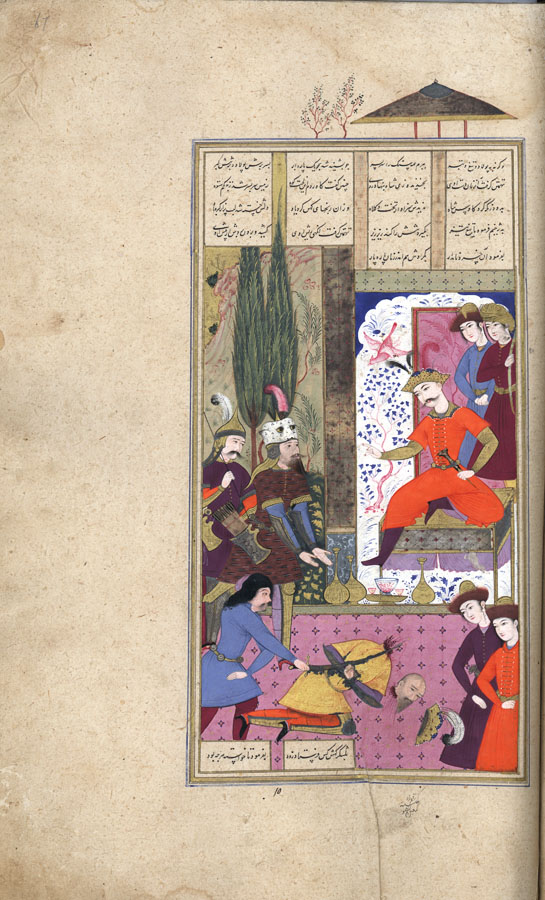The King of Māzandarān Dies
The illustration depicts the narrative at the point when the King of Māzandarān is being hacked to pieces by the executioner. His head, already severed from the body, and bleeding torso lie in the center foreground. The executioner, a man with long hair matted to one side, encountered previously on folio 52V, is shown here in profile in the left foreground, still hacking away at the body. Two youthful observers in long dresses and fur trimmed hats intently view the event from the right foreground. In the upper right, shown in a scale larger than the other personages, is Shah Kāvos, seated with one foot under him on an elevated, four legged, square throne. He wears a feathered crown, boots, and a full length robe. His left hand rests upon the dagger stuck in his belt, his right arm is raised with forefinger extended, having apparently just given the command to the executioner to proceed. Behind the shah, on the extreme right, are two standing servants. One with a fur trimmed hat clasps his hands before him, while the other, wearing a turban, holds the shah’s sword vertically in ceremonial fashion. A multilobed finely painted panel of foliage with a flying bird serves as a backdrop to the shah. To the left of this is a tiled column, and beyond it to the left, a garden with two slender cypress trees, a rock formation, and some shrubbery. On the far left, in front of the garden, stands a mustached guard with a lance and pointed steel helmet. He is partially obscured by Rostam, who appears in front of him, more towards the center of the composition. Rostam wears his customary tiger skin coat and leopard skin headdress, standing with his arms outstretched in the direction of the King of Māzandarān, to whom he has apparently just addressed his threat. The foreground floor is tiled, and several flacons and dishes are spread out at the feet of Shah Kāvos.
There are four columns of text above the painting. Two are comprised of five lines each, the others are four lines each. The two remaining lines are written in the bottom left corner in two column fashion. A ruled frame encloses painting and text except for a pavilion and two small branches which protrude into the top margin. The painting is signed in the lower margin, to the right center, in miniscule characters in Moʿin’s hand: raqam zad kamina Moʿin-e Moṣavver. Not dated.
Painting references:
Welch, AK4_1978, p.89, Ms.22, folio 67r (not illustrated).
Text references:
Warner, II, p.75; Mohl, I, p.447; Levy, p.58.
Robert Eng
Last Updated: June 22, 2011 | Originally published: June 22, 2011
